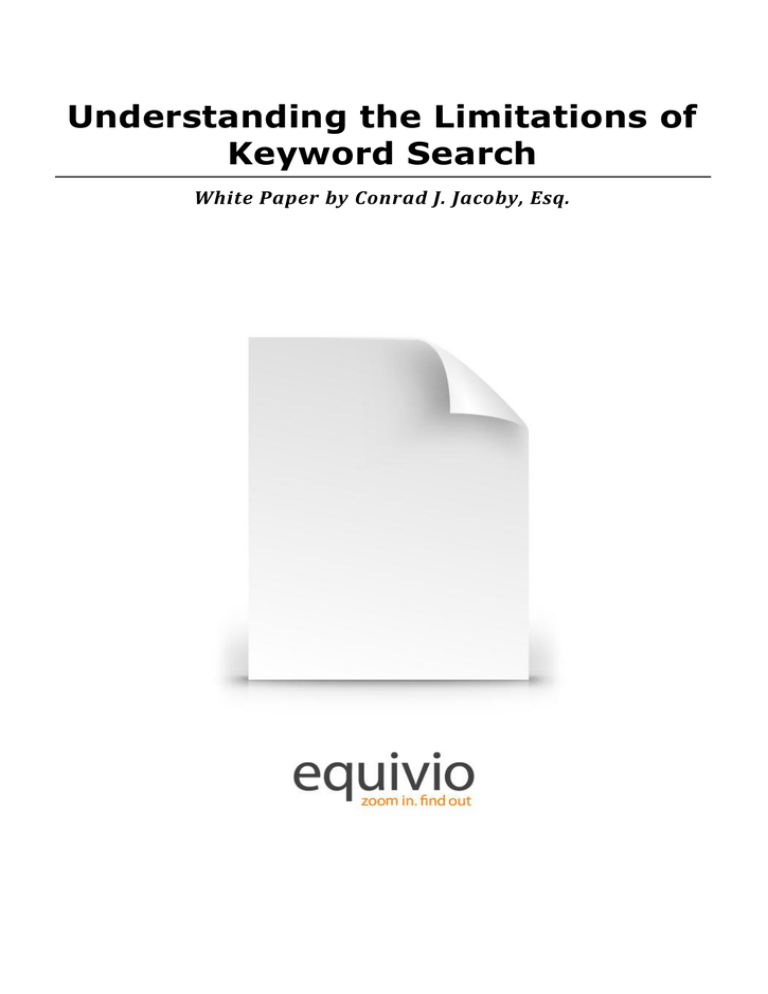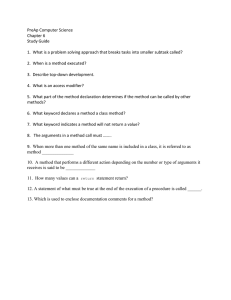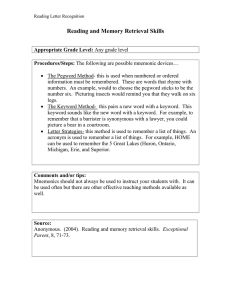
Understanding the Limitations of
Keyword Search
White Paper by Conrad J. Jacoby, Esq.
Attorneys have used the same basic technique to find potential relevant evidentiary
documents in litigation for generations: (1) find a document of significance to a case;
then (2) try to find other documents like it to complete the story. For attorneys and
paralegals skimming through boxes of documents, specific words and phrases have been
useful indicators of a document’s potential value, permitting them to use concrete
criteria to exclude documents in a discovery document collection and to focus on a
smaller group of documents much more likely to have genuine relevance to the legal
dispute. In particular, keywords have provided clear and simple direction to the young
attorneys, paralegals, and other members of a legal team not fully familiar with the
issues in the case who are often drafted to assist with document review projects.
Today, keyword search continues to be a common, if not the most common, technique
used to search discovery document collections for potentially relevant material.
Attorneys often use their own knowledge of a case and its underlying subject matter to
develop a list of terms likely to occur in documents of interest, but some also use subject
matter and even linguistic experts to develop extensive lists of words and phrases likely
to occur in relevant documents. Because search term lists are developed through
brainstorming, not all search terms will actually occur in the target document population.
However, it’s difficult, if not impossible, to predict in advance which search terms will
best identify documents, so queries are typically refined through testing and sampling.
Computer technology is essential to applying complex keyword searches to large
document populations. Computers have made it possible to quickly search thousands, if
not millions, of documents with a single query. Computer programs and the Boolean
logic used to control them have also made it possible to create complex searches that
can include some terms, exclude others, and check whether key terms are within a
specified proximity to one another. None of these complex searches could be carried out
with any degree of accuracy using only human reviewers, but automated keyword search
has been accepted by attorneys, judges, and litigants as an objective method for
locating documents.
And yet, for all its power, the limitations inherent in keyword search routinely generate
unsatisfactory results when this method is used to search discovery document
collections. Keyword search possesses the seemingly contradictory weaknesses of
finding too few documents (under-inclusion) and finding too many documents (overinclusion). Of late, these limitations have led to a small but growing judicial voice
questioning whether keyword search alone meets the legal standards for reasonably and
defensibly looking for potentially relevant documents and information.
KEYWORD SEARCH IS UNDER-INCLUSIVE
The greatest challenge in organizing a document collection of any size is properly
classifying its documents. For litigation document reviews, improper categorization may
have extremely significant consequences, such as when documents protected by
2
attorney-client privilege are inadvertently disclosed to an opponent. Keyword search has
been used for many years to help legal teams quickly identify documents that appear to
have relevance to the immediate legal dispute.
Unfortunately, keyword search offers only an imperfect solution to this problem because
it misses many relevant documents. By its fundamental nature, keyword search is
sharply focused to find the exact terms specified in the query. Search for documents
containing the word “car,” and you’ll find exactly what you’ve requested. However,
you’ll miss documents containing potentially relevant words like “automobile,” “Ford,”
“GM,” and “Toyota.” One can compensate by increasing the number of search terms and
by adding stem searching to find plurals of words, but the results will still likely overlook
some relevant materials.
It’s seemingly always possible to add more search terms to enhance a keyword search
query, but even with hundreds of search terms (one recent reported case, In re Fannie
Mae Securities Litigation, _ F.3d _, 2009 WL 215282009, U.S. App. LEXIS 9 (D.C. App.
Jan. 6, 2009), involved 400 search terms), questions can still remain as to whether the
search authors included enough relevant terms and concepts in their query. Many
organizations and professions develop an internal vocabulary for common objects or
activities that take place. Within the medical field, for example, “PDR” refers to the
“Physicians’ Desk Reference,” a collection of Food and Drug Administration-approved
drug labels and warnings. However, at NASA, “PDR” refers to a “Preliminary Design
Review,” a project management milestone required in all engineering projects.
Outsiders routinely overlook one or more specialized terms and fail to include them in a
search query. As a consequence, relevant documents are not caught by the search
query.
Keyword searches may also overlook key documents due to human error. Many
litigation document collections contain voluminous amounts of e-mail messages, many of
which are sent without being spell-checked and from mobile e-mail devices with thumb
keyboards that encourage innovative abbreviation. Keyword search will overlook
messages where key terms have been misspelled or otherwise fail to match the search
criteria. Some of the most important documents in a case—raw, unbiased, timely
commentary written as events are taking place—may be overlooked for this reason.
Compelling evidence of the limitations of keyword search appears in the most recent
results of a multi-year study conducted by the National Institute of Standards and
Technology. The Text Retrieval Conference (“TREC”) Legal Track study, which is
designed and managed by a mixed group of academics and legal practitioners, seeks to
evaluate the ability of different search technologies, including keyword search and pure
human review, to identify relevant documents in a standardized collection in which the
actual mix of documents is already known. In 2008, as in prior years, participants were
organized into mock legal teams and asked to develop keyword search queries that
would identify documents relevant to legal claims raised in mock complaints.
3
Results of the 2008 TREC “consensus” keyword searches were compelling. While some
of the topic-specific Boolean queries found more documents than others, on average,
Boolean keyword search found only 24% of the total number of responsive documents in
the target data set. Overview of the TREC 2008 Legal Track at pp. 8-10 (available at
http://trec.nist.gov/pubs/trec17/papers/LEGAL.OVERVIEW08.pdf. These findings are
consistent with the 2007 TREC results (22% vs. 24%), and they strongly support the
finding that many if not most relevant documents are overlooked when using keyword
search as the sole means of identifying responsive materials.
KEYWORD SEARCH IS OVER-INCLUSIVE
At the other end of the spectrum, keyword search queries routinely vacuum up many
wholly irrelevant documents whose review wastes time and money. The mere mention
of a term is no indication that it is being used in a relevant context. In a products
liability lawsuit, searching for documents containing the word “car,” for example, will
likely also capture documents about car pools, car seats, car sickness, and car washes.
If stem searching is used in conjunction with keyword search, the same query might also
return documents discussing carrots and cartons. In almost all cases, such unexpected
search results are simply not relevant to the intended purpose of the query and are
unintended byproducts of an unduly-broad search query.
Increasing the number of search terms to reduce under-inclusion further exacerbates the
problem of capturing irrelevant documents. In the In re Fannie Mae Securities Litigation
case previously cited, the requesting party’s 400 keyword search terms flagged 80% of a
government agency’s entire e-mail archive as being potentially relevant to an underlying
legal dispute in which it was not even a named party. It’s extremely likely that most of
the hundreds of thousands of documents so identified would ultimately be deemed
irrelevant, but that determination will only be the voluminous search results are
individually reviewed. Such a task can consume enormous resources (9% of a Federal
Agency’s entire annual budget in the Fannie Mae Securities case) while providing only
modest benefits.
KEYWORD SEARCH ALONE DOES NOT PROVIDE
LEGALLY DEFENSIBLE RESULTS
In light of well-publicized cases where a litigant failed to locate key documents until long
after fact discovery had closed, many federal and state courts are taking a harder look at
the reasonableness of a producing party’s efforts to identify relevant documents for
production in litigation. A growing number of courts have become increasingly skeptical
about the adequacy of keyword search as the sole means of identifying potentially
relevant documents. For example, in the widely-cited case of Victor Stanley, Inc. v.
Creative Pipe, Inc., 250 F.R.D. 251 (D. Md. 2008), presiding Judge Paul Grimm wrote:
4
“[W]hile it is universally acknowledged that keyword searches are useful tools for
search and retrieval of ESI, all keyword searches are not created equal; and there
is a growing body of literature that highlights the risks associated with conducting
an unreliable or inadequate keyword search or relying exclusively on such
searches for privilege review.”
Victor Stanley, 250 F.R.D. at 256-57.
Another court has even called into question whether attorneys are competent to develop
keyword searches in the first place:
“[F]or lawyers and judges to dare opine that a certain search term or terms would be
more likely to produce information than the terms that were used is truly to go where
angels fear to tread. This topic is clearly beyond the ken of a layman and requires that
any such conclusion be based on evidence that, for example, meets the criteria of Rule
702 of the Federal Rules of Evidence.”
United States v. O’Keefe, 537 F. Supp. 2d 14, 24 (D.D.C. 2008).
Taken together, these opinions strongly hint that while keyword search has not been
completely discredited, new search and review technologies, particularly affordable
methods for grouping and clustering documents based on their content, are changing the
expectations that judges have for litigants who use automation to search document
repositories and collections for relevant evidence.
KEYWORD SEARCH’S INFLEXIBILITY CAN CAUSE
TIMING AND BUDGET ISSUES
Finally, although it’s not a legal issue per se, relying exclusively on keyword search to
define a review document population can strain both discovery budgets and timelines
when a case’s underlying variables shift. For example, parties may negotiate a series of
keyword search terms to define the documents that will be reviewed for relevance. One
factor of the negotiation is the size of the search results—if a query flags too many
documents, the parties agree that the search is overbroad. However, the legal claims in
a case may shift after the negotiation is complete, due to an amended complaint or
answer—or the joinder of additional litigants. Adding new search terms to the existing
queries already approved by the parties may cause an unexpectedly large increase in
search query results, generating a much larger (and much more expensive) document
review for the producing party than anticipated. Depending on how far the case has
developed before changes in its legal underpinnings, it may not be possible for the
producing party to re-negotiate the initial search terms—or for the litigant to apply to the
court for relief from a suddenly onerous document review.
5
Keyword search results can also exceed expectations when keyword search terms are
based on the results of searching only a part of the target document population. Under
the Federal Rules of Civil Procedure and an increasing number of state court analogs,
parties must reach agreement on the scope of discovery early in a case—often before
document collection is complete. As a result, keyword searches are tested against the
documents that a litigating party has on hand at that stage in the dispute. However, as
the document collection process continues to bring in materials from a broader range of
repositories, initial estimates based on searches of the most easily accessible documents
may be materially incorrect. For example, e-mail messages are often some of the first
material collected and searched early in a case. However, these messages, many of
which are fairly short or completely unrelated to the grounds of the dispute, may not
contain many uses of terms of interest that are included in a negotiated keyword search.
However, when the same search query is later applied to a more balanced document
population that contains corporate memoranda, reports, and other more verbose
documents, the search results will skew sharply higher than initial projections. And
again, the producing party is left with a far larger number of documents to review for
possible production—and relatively few ways to seek relief.
CONCLUSION
Keyword search remains an important starting point for most document review projects
and for legal professionals who must quickly get an approximate sense of the potentially
relevant documents within a collection. Increasingly, however, keyword search must be
viewed as only one of several tools for identifying relevant documents. Relying
exclusively on keyword search, especially in light of new tools and increasingly educated
judges and opponents, runs the risk of mismanaging a key part of litigation fact
discovery to the grave detriment of the client.
6
ABOUT EFFICIENTEDD
Copyright 2009 by Conrad J. Jacoby. All rights reserved.
Conrad Jacoby is the founder of efficientEDD, a consultancy specializing in
electronic discovery and litigation information management issues. A seasoned
litigator as well as a technology consultant, Mr. Jacoby writes and lectures
extensively on electronic discovery issues. He is a long-standing member of the
Sedona Conference Working Group on Electronic Document Retention and
Production and is also the co-founder and Chair of the District of Columbia Bar
Litigation Section’s E-Discovery Committee. Mr. Jacoby can be reached at
conrad@efficientEDD.com.
ABOUT EQUIVIO
Equivio develops text analysis software for e-discovery. Users include the DoJ,
the FTC, KPMG, Deloitte, plus hundreds of law firms and corporations. We offer
Zoom, a platform for analytics and predictive coding.
Zoom organizes
collections of documents in meaningful ways. So you can zoom right in and find
out what’s interesting, notable and unique. Request a demo at
info@equivio.com or visit us at www.equivio.com.
Zoom in. Find out.
Equivio™, Equivio Zoom™, Equivio>NearDuplicates™, Equivio>EmailThreads™, Equivio>Compare™, Equivio>Relevance™ are
trademarks of Equivio. Other product names mentioned in this document may be trademarks or registered trademarks of their
respective owners. All specifications in this document are subject to change without prior notice.
© Copyright 2012 Equivio
7






